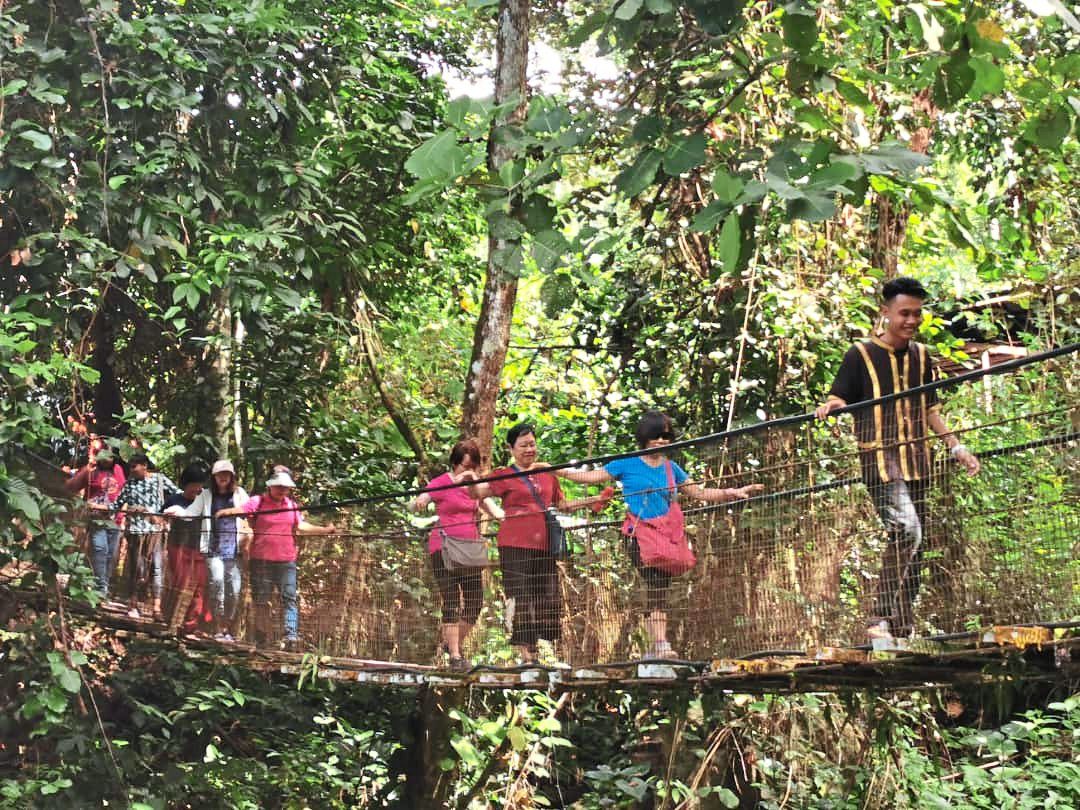The writer and her group crossing the hanging bridge at the village.
Sometime in early 2020, before the Covid-19 movement control order began, a group of senior citizens (myself included) from the Klang Convent Old Girls Association went on a trip to Kota Kinabalu, Sabah.
We visited the Mari Mari Cultural Village on one of the days we were in KK. When we arrived at the village, I was not too impressed by how it looked so I lowered my expectations of the place.
Two guides welcomed us at the entrance, ready to lead us through our experience. After giving us a brief explanation of the ethnic groups in Sabah, the guides then divided us into two smaller groups.
Once the doors to the entrance opened, we were faced with a hanging bridge and we had to cross it to get into the village. The bridge started swaying as soon as we walked on it – how exciting!
The first stop for my group was at the traditional Dusun house, which had a few rice wine urns on display. The guide showed us the ingredients needed to make the rice wine, and explained the process of making it. We even got the chance to sample a taste of the rice wine or lihing.
However, I was actually more intrigued by Dusun food. I had heard of the different native cuisines in Sabah but never tried any. At the village, we were shown tuhau and bosou. Tuhau is a kind of wild ginger that has a pungent smell. The natives would usually pickle the tuhau and eat it as an accompaniment to the main meal.
Meanwhile, bosou is a dish of fermented fish or pork (we were presented with fish at the village). The fish – usually river fish – is marinated with salt and pangi seed, a local fruit, and then fermented for at least two weeks.
As we walked to the Rungus house, we got a bit excited to see a Rungus girl clad in her traditional attire. Her black dress was so beautiful as it had embroidered horizontal lines and gold threading, and complemented with colourful beaded necklaces and copper accessories.
At the Lundayeh house, the locals showed us their traditional clothes, which were made from tree bark. It seemed like quite a difficult process, but also amazing at the same time.
We were also shown how to make fire using the dried fibrous parts of a tree.
Our next stop was at the Murut house, which, to our excitement, had a bamboo trampoline. According to Murut folklore, a tribal chief once thought of an ingenious way to reward his warriors who had returned from their battles. He built a bamboo trampoline or lansaran and hung some kind of reward on a pole, which he placed right above the lansaran. Warriors would then have to jump as high as they can to grab the reward.
Our group was invited to try our luck on the lansaran and a few seniors gamely hopped on it to see how high they could jump.
The last house was the Kadazan and Dusun house, which are two of the biggest ethnic groups in Sabah. Some of their cultures seem quite familiar to us, probably because folks in Peninsular Malaysia are more exposed to these two ethnic groups.
We were also treated to a rousing performance called the magunatip, which was kind of like a bamboo dance. We were served a simple lunch with local delicacies after that, although bosou and tuhau were not on the menu.
The trip to Mari Mari Cultural Village really opened our eyes to the different people, cultures, traditions and food that can be found in Malaysia. It was an interesting and wonderful visit.
The views expressed are entirely the reader’s own.







